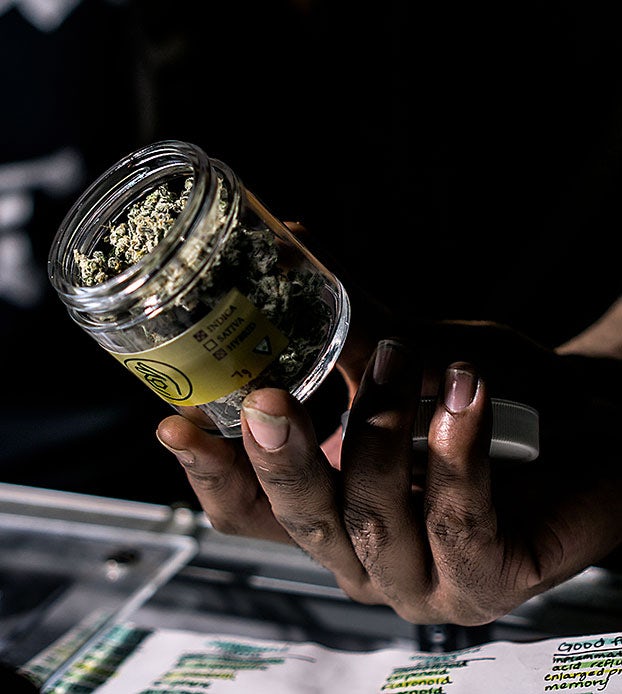Cannabis research has taken flight in recent years as regulatory and medical attitudes have begun to shift. In the past, doing scientific and clinical research on cannabis and its medical benefits was very difficult.
The sheer volume of new information and scientific understanding being published these days is almost impossible to keep up with. Many of those developments and directions have the potential to be game-changers for a number of diseases. Others are simply fascinating.
➤ Get your medical card now with The Cannigma Medical
Since you’re probably not looking through medical journals, we decided to do the hard part for you. The following are five of the most fascinating and eye-catching pieces of published medical cannabis research that we’ve seen lately.
Are Cannabis Users Less Likely to Gain Weight?
The results from a national three-year study trend in that direction. Evidence from a Michigan State University (MSU) study suggests that adults who smoke cannabis weigh less than those who do not. The findings, published in the International Journal of Epidemiology, challenge the long-held belief that marijuana users gain weight due to the plant’s hunger-inducing side effect commonly known as themunchies. The study suggests that new and persistent users are actually less likely to be overweight or obese.
Lead author and researcher Omayma Alshaarawy, an assistant professor of family medicine at MSU, and her team found that while the weight difference among cannabis users and non-users was modest (around 2 lbs for a 5-foot-7-inch participant weighing about 200 pounds) the variance was prevalent among the entire sample size. “And, only 15% of persistent users were considered obese compared to 20% of non-users,” she stated in an interview. So, what is it about marijuana that seems to affect weight? To put it in simplest terms, Alshaarawy said cannabis use can modify how certain cells and endocannabinoid receptors respond in the body and influence metabolism and weight gain.
The bottom line: More research needs to be done, as cannabis use effects men and women differently, dosage varies, and different THC-to-CBD ratios must be accounted for. In the meantime, cannabis should probably not be considered a diet aid.
‘Runner’s High’ Linked to Cannabinoid Receptors
For decades, it was believed that exercise-induced endorphin release is responsible for runner’s high — that sense of well-being you experience after prolonged exercise.
Endorphins are very large molecules that cannot easily move from the blood into the brain, so it is unlikely that they are solely responsible for the feelings associated with runner’s high. Scientists believe the effect can be attributed to other chemicals in the body that produce similar pain-relief and bliss.
Evidence now suggests that endocannabinoids may play a role. A study from the University of Heidelberg, published in the Proceedings of the National Academy of Science, shows that mice who run on a wheel increase endocannabinoid production and decrease both anxiety and pain. In particular, this form of exercise increased blood levels of both β-endorphin (an internally created opioid that reduces pain messaging) and anandamide (an endogenous endocannabinoid nicknamed the bliss molecule that improves emotional state.).
In a series of experiments, the team was able to show that the reduction in anxiety-like behavior after long-distance running depends on receptors on forebrain neurons that focus on blocking certain brain signals (pain) and decreases that activity in the nervous system. These cannabinoid receptors are crucial for a runner’s high.
Cannabis Can Improve Night Vision
Fifteen years ago, a multi-disciplinary team from around the world published its findings in The Journal of Ethnopharmacology observing that Moroccan fishermen and mountain dwellers have improved night vision after smoking kif, a mix of cannabis sativa and tobacco. Field studies were performed with subjects before and after smoking kif. Improvements in night vision were noted after THC or cannabis. It is believed that this effect is dose-dependent and cannabinoid-mediated at the retinal level. For example, one subject saw no changes until a decrement in sensitivity was observed at 10mg, and maintained at 20 mg of oral THC, suggesting a dose-response effect. The study supports the previous ethnobotanical observations that cannabis may improve night vision, and in particular, reports of improved night vision among Jamaican fishermen after ingesting a cannabis tincture.
Why is this important? The researchers of the study, led by Dr. Ethan Russo, hope that further testing may find possible clinical application of these results in retinitis pigmentosa, a genetic disorder that causes loss of vision and symptoms include trouble seeing at night and decreased peripheral vision. Further study may reveal whether this clinical application of cannabis could be added to treatment of pain, spasticity of multiple sclerosis, and nausea of chemotherapy as recognized indications for the plant.
Cannabis and Morning Sickness?
More young moms-to-be are using cannabis to relieve morning sickness — but that doesn’t mean it’s recommended for pregnant women.
Many women experience nausea and/or vomiting during pregnancy, ranging from mild to extreme. Cannabis (and in particular Cannabis sativa) may be used therapeutically to mitigate pregnancy-induced nausea and vomiting. Michael Smith, a Foundation for Health Research Postdoctoral Fellow, Department of Sociology, University of Victoria, Victoria, BC, Canada surveyed 84 women and their cannabis use. Of the 79 respondents who had experienced pregnancy, 51 (65%) reported using cannabis during their pregnancies. While 59 (77%) of the respondents had experienced nausea and/or vomiting of pregnancy, 40 (68%) used cannabis to treat the condition, and of these respondents, and 37 (more than 92%) rated cannabis as “extremely effective” or “effective.”
Nausea is a medically approved indication for marijuana in some states where medical use has been legalized. However, there is often a difference between regulated marijuana from a dispensary and that from the illicit market. And while the findings support the need for further investigations into cannabis use for nausea and vomiting during pregnancy, it is worth noting that the American Medical Association states that marijuana during pregnancy is unsafe.
Cannabis as a Neuroprotectant After Traumatic Brain Injury
Several studies have looked at the neuroprotective effects of cannabinoids, especially after a traumatic brain injury. In 2014, a team of researchers at Harbor-UCLA Medical Center, published their findings regarding the relationship between the presence of THC and mortality after a TBI. The three-year review of data focused on over 400 patients who sustained a TBI and who, after the injury, had also been administered a toxicology blood test screening for the presence of THC. The group of TBI patients that whose toxicology reports showed they had THC in their system at the time of their injury was compared with those who tested negative — with respect to injury mechanism, severity, disposition, and mortality. Mortality in the THC-positive group was significantly decreased compared with the THC-negative group, thereby associating the presence of THC with survival after a TBI.
Another study, a 2017 review of existing pre-clinical studies on traumatic brain injury, assessing the therapeutic potential of cannabinoids and manipulations of the endocannabinoid system to alleviate TBI pathology, including the above-mentioned study. Additionally, the team looked at TBI-induced behavioral deficits which also respond to manipulations of the endocannabinoid system.
According to the review, evidence suggests that THC is neuroprotective when administered prior to a TBI. Curiously, an extraordinarily a low dose reduced injury-induced cognitive deficits in mice. And, even though 80–90% of THC is excreted within five days of administration, individuals may experience very low THC concentrations for prolonged periods. This presumed prolonged exposure, as well as other potentially neuroprotective cannabinoids, such as CBD, may be responsible for the survival effects found in cannabis-exposed TBI patients.
Sign up for bi-weekly updates, packed full of cannabis education, recipes, and tips. Your inbox will love it.

 Shop
Shop Support
Support
















